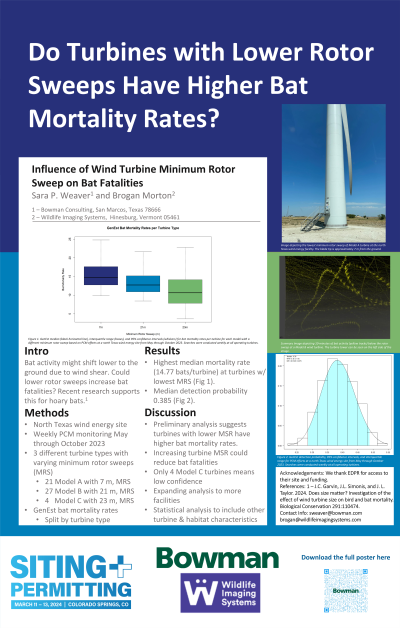Back

Multi-tech
Biology, Behavior, and Wildlife Issues (Bats, Eagles, Fish, Big Game, Small Mammals, and other species)
Influence of Wind Turbine Minimum Rotor Sweep on Bat Fatality
Tuesday, March 12, 2024
5:00 PM – 6:00 PM MT


Sara Weaver, MS, PhD (she/her/hers)
Principal - Natural Resources Director
Bowman
San Marcos, Texas
Presenter(s)
Presentation Description: Several studies have assessed influence of wind turbine characteristics on bat mortality rates with varying results. However, to our knowledge no one has investigated the effect of minimum rotor sweep (MRS), defined as the distance from the ground to the blade tip at the bottom of its swing. Recent thermal camera studies conducted by the authors indicate bat activity varies vertically in the air column and is often much higher at the bottom of and below the rotor sweep area (RSA). Bat activity might increase below the RSA due to vertical wind shear, which is an increase in wind speed with an increase in elevation above ground level. If supported, a wind turbine’s MRS could be a predictor of bat fatality. Our objective is to assess what turbine characteristics influence bat mortality rates, including the first test of MRS using results from bat post-construction monitoring (PCM) at three different wind facilities, two adjacent facilities in southern Texas with three different MRS heights and one facility in northern Texas with three different MRS heights. The bat species most impacted at these sites include (in alphabetical order) Brazilian free-tailed, eastern red, evening, hoary, and northern yellow bats. Models will include GenEst median mortality rates by turbine model as the response variable, turbine characteristics and habitat characteristics as fixed effects, and year of PCM as a random effect. If MRS influences bat mortality rates, it might be a mitigation tool such that selecting a turbine model with a higher MRS could reduce bat fatalities. Analyses are currently underway and preliminary results will be presented.
